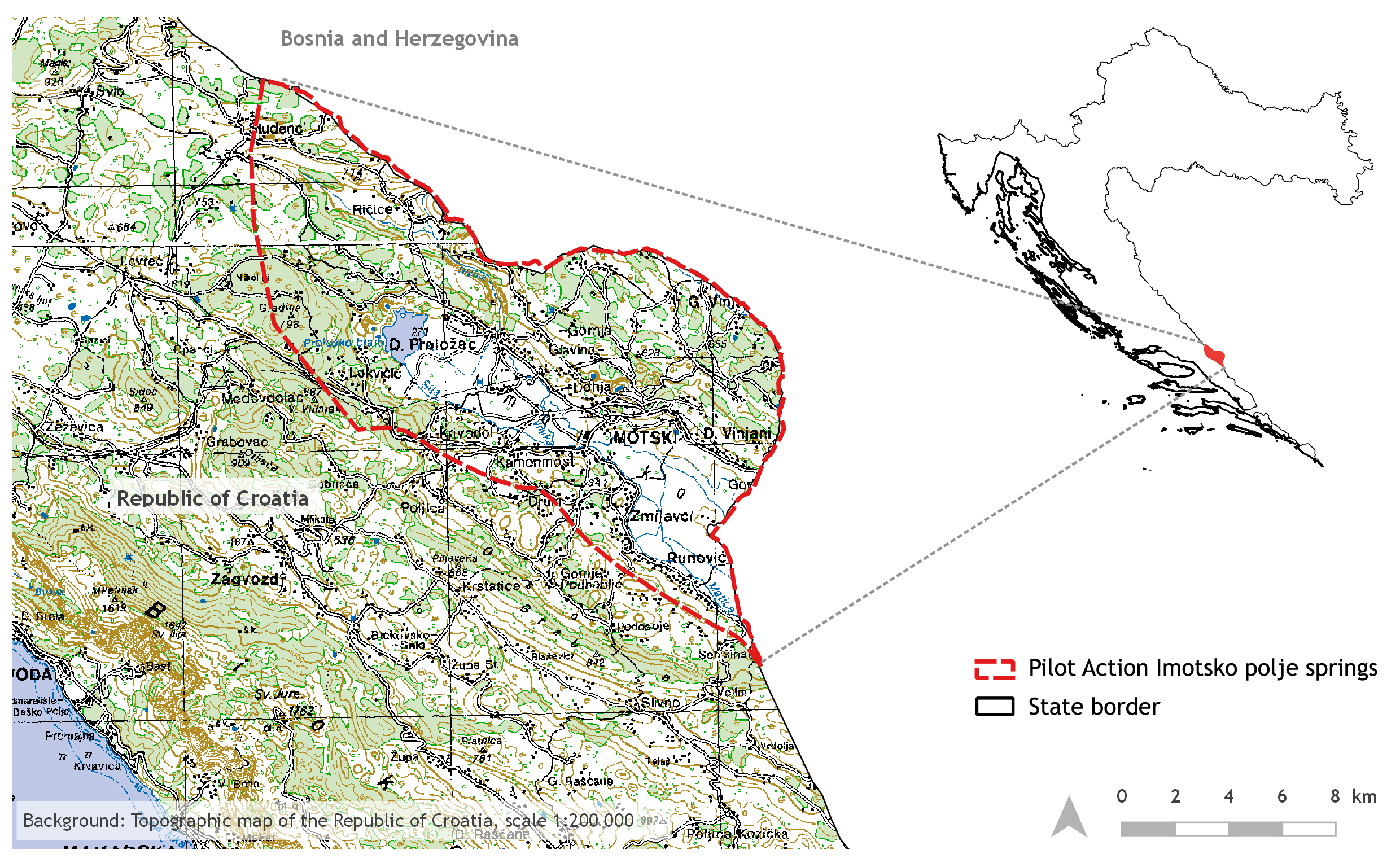PA 2.4_2 – Imotsko polje springs
Imotski field is a karstic field partially situated in Croatia and partly in Bosnia and Herzegovina. Its total surface area is 92 km2, of which 48% is in Croatia. The pilot area of the spring catchment area of the Imotski field is a typical karst catchment characterized by very complex and intricate hydrogeological features. This area is faced with two basic problems, on the one hand by the flooding of certain areas, on the other hand, by the intensive agricultural activity.
| Objective(s) of pilot actions / Aim of testing in the territorial level | Given that the main objective of the PROLINE-CE project is the protection of drinking water, two pilot areas were selected in the southern part of Croatia, which is the most vulnerable part of Croatia in relation to the quality and quantity of drinking water. The drinking water protection zones in these areas have not yet been established and adopted. Main focus in these pilot areas is to develop and implement measures for drinking water quality and quantity protection in relation to land use activities (above all agricultural activities) and climate change scenarios. |
| Expected achievable results | Hydrological model will provide scenarios of average annual discharges and assessment of possible water shortages in terms of expected climatic conditions in the future. Hydrogeological research carried out within this project will provide the basis for hydrological models, as well as an overview of groundwater condition, its origin and quality. This will allow estimation of trends in water quality parameters in the future in relation to the conducted prognostic hydrological models. The main results of activities in these pilot areas is evaluation of the impacts of agriculture and climate change on the drinking water quality and quantity; and based on this to develop and implement measures for drinking water quality and quantity protection in relation to land use activities (above all agricultural activities) and climate change scenarios. Brochures will be produced for stakeholders and local population, which will highlight the main issues related to the protection of drinking water and to propose solutions. In addition, direct communication with local stakeholders will help to try to find ways how to successfully implement the proposed measures in the future. All of these will create the basis for effective drinking water resources protection and management, which will contribute to the adoption of common measures to protect the drinking water resources in the partner countries in the future, as recent climate changes dangerously and rapidly threaten these, for the life necessary resources. |
| Timeframe of implementation of achievable actions | Hydrological model which encompasses water balance analysis and assessment of climate change impacts on both pilot areas will be done till the beginning of May. The brochures will be made in July. Direct communication with the stakeholders will be carried out during the duration of the project in the frame of T3 and T4. |
| Expected benefits for national/regional stakeholders | If measures will be successfully implemented at the local level, it can be a good example and help decision makers to apply similar measures in other karst areas of Croatia and Europe, especially in the transboundary aquifers of Bosnia and Herzegovina which are in direct connections with the pilot areas. Since Bosnia and Herzegovina is not in the European Union and is not subject of EU directives, the results of the project could contribute to effective management of of these transboundary karst areas. The results of the project will provide an excellent base for the establishing the drinking water protection zones as well as the future general spatial planning of the area. |
| Expected benefits for local stakeholders | Local stakeholders will be familiarized with the main problems related to drinking water protection in pilot areas and possible solutions through the results of conducted researches, brochures and direct communication. Given that pilot areas are in the part of Croatia where people are still quite opposed to changes, it was decided to share them the brochures and try to raise awareness and point out that they are the important link in the chain water management. Raising awareness of the population would enable local stakeholders to facilitate the implementation of protection measures. |

Reports:
Deliverables T2.1.2 can be found here: Transnational report about best management practices and annex 6: Best management practices in PA 2.4_2.
Deliverable T2.1.4 can be found here: Descriptive documentation about PA 2.4_2.
Deliverable T2.1.5 can be found here: Set-up report about adaptation of the transnational concept to PA 2.4_2.
Deliverable T2.2.2 can be found here: Partner-specific pilot action documentation.
Deliverable T2.3.1 can be found here: Evaluation report for each pilot action.
